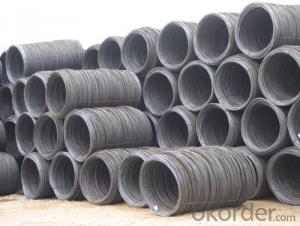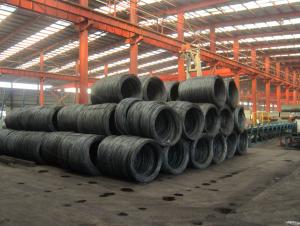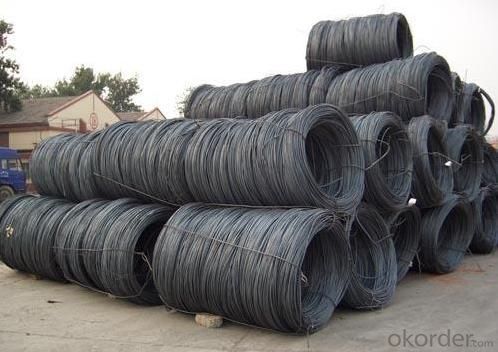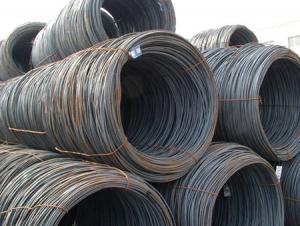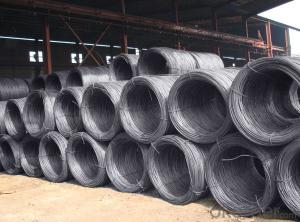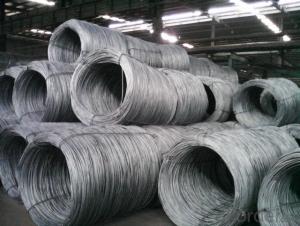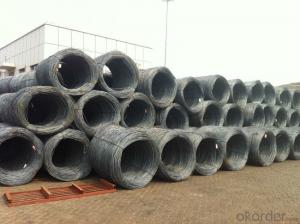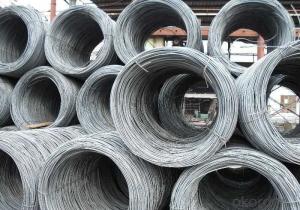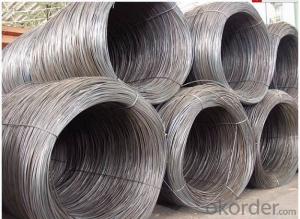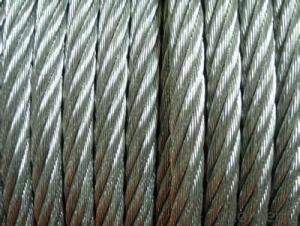High Quality Steel Wire Rod SAE1008 8.0mm
- Loading Port:
- Tianjin
- Payment Terms:
- TT or LC
- Min Order Qty:
- 50 m.t
- Supply Capability:
- 10000 m.t/month
OKorder Service Pledge
OKorder Financial Service
You Might Also Like
High Quality Steel Wire Rod SAE1008 8.0mm
Product Description:
Specifications of Wire Rod SAE1008:
Grade: SAE1008 Standard: ASTM
Diameter: 8.0mm
Alloy or Not: Alloy
Technique: Hot Rolled Place of Origin: China Mainland
Chemical Composition:
Please kindly find our chemistry of our material based on SAE1008 as below for your reference:
Grade | Chemical Composition (%) | |||||
C | Mn | S | P | Si | ||
SAE1008 | 0.10max | 0.32max | 0.045max | 0.040max | 0.30max | |
Mechanical properties | ||||||
Yield strength(N/mm2) | Tensile strength(N/mm2) | Elongation (%) | ||||
≥195 | 350-380 | ≥32 | ||||
Usage and Applications of High Quality Steel Wire Rod SAE1008 8.0mm:
After hot-rolled the products shaped into coil and delivery as finished product, including round, square,rectangular, hexagonal and so on. Since most of the products are round, it is generally called wire rod. Carbon steel wire rod is widely used in construction and manufacturing. Carbon steel wire rod is mainly used for reinforcement of reinforced concrete and welded structure or reprocessed (roberts , nail, etc.) materials, especially used to produce wire drawing, welding electrode, nails, spring, electronic, precise machinery parts and so on.
Packaging & Delivery of High Quality Steel Wire Rod SAE1008 8.0mm:
Packaging Detail: products are packed in coil and then shipped by container or bulk vessel
Each coil weight: About 2.05MT
Delivery Detail: within 45 days after received deposit or LC.
Label: to be specified by customer, generally, each bundle has 1-2 labels
Trade terms: FOB, CFR, CIF
FAQ:
Q1: Why buy Materials & Equipment from OKorder.com?
A1: All products offered byOKorder.com are carefully selected from China's most reliable manufacturing enterprises. Through its ISO certifications, OKorder.com adheres to the highest standards and a commitment to supply chain safety and customer satisfaction.
Q2: How do we guarantee the quality of our products?
A2: We have established an advanced quality management system which conducts strict quality tests at every step, from raw materials to the final product. At the same time, we provide extensive follow-up service assurances as required.
Q3: How soon can we receive the product after purchase?
A3: Within three days of placing an order, we will arrange production. The shipping date is dependent upon the quatity, how many sizes you want and the plan of production, but is typically 1 month to 2 month days from the beginning of production.
Images of High Quality Steel Wire Rod SAE1008 8.0mm:
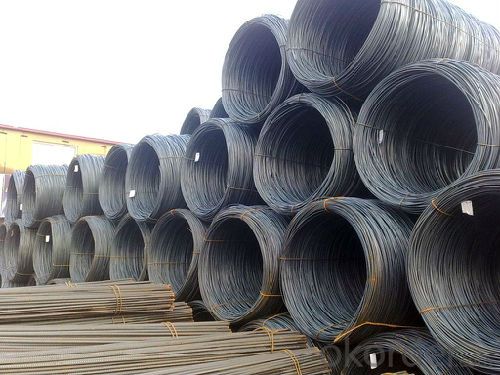
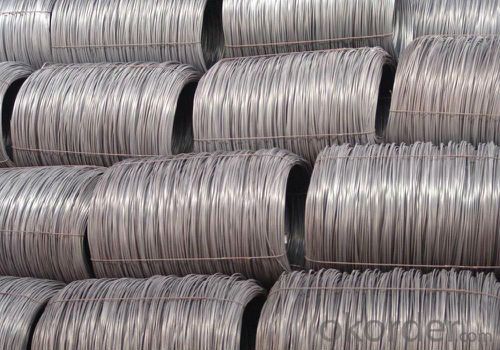
*If you would like to get our price, please inform us the size, standard/material and quantity. Thank you very much for your attention.
- Q: What are the different types of steel wire rod annealing processes?
- There are several different types of steel wire rod annealing processes used in the industry. These processes are designed to improve the mechanical properties and overall quality of the steel wire rod. 1. Full Annealing: This process involves heating the steel wire rod to a high temperature and then slowly cooling it down to room temperature. This allows for the complete transformation of the steel's microstructure, resulting in improved ductility and toughness. 2. Isothermal Annealing: In this process, the steel wire rod is heated to a specific temperature and held at that temperature for a certain period of time. This allows for the formation of a uniform microstructure throughout the wire rod, resulting in improved mechanical properties. 3. Spheroidizing Annealing: This process is specifically used for high-carbon steel wire rods. It involves heating the wire rod to a temperature just below its melting point and holding it at that temperature for a prolonged period of time. This allows for the formation of small spheroidal carbides within the microstructure, resulting in improved machinability and formability. 4. Process Annealing: This annealing process is used to relieve internal stresses and improve the cold-working properties of the steel wire rod. It involves heating the wire rod to a specific temperature and then cooling it rapidly, typically in water or air. 5. Normalizing: Normalizing is a type of annealing process that involves heating the steel wire rod to a temperature slightly above its upper critical temperature and then cooling it in still air. This process helps to refine the grain structure of the steel, resulting in improved strength and toughness. Overall, these different types of steel wire rod annealing processes are used to tailor the mechanical properties of the steel to meet specific requirements for various applications.
- Q: What are the different types of steel wire rod cooling methods?
- There are several different types of steel wire rod cooling methods, including air cooling, water cooling, and controlled cooling.
- Q: What are the common applications of alloy steel wire rod?
- Due to its unique properties and characteristics, alloy steel wire rod finds a wide range of applications. Some of the common uses of alloy steel wire rod include: 1. In the automotive industry, alloy steel wire rod is extensively utilized for producing various components like springs, suspension systems, wheel rims, and engine parts. Its high strength and durability enable it to withstand demanding conditions and loads experienced by these components. 2. The construction industry also heavily relies on alloy steel wire rod. It is employed in manufacturing reinforcing bars (rebars) necessary for strengthening concrete structures such as bridges, buildings, and highways. The high tensile strength and corrosion resistance of the wire rod ensure the longevity and structural integrity of these constructions. 3. Alloy steel wire rod finds applications in various manufacturing processes like welding, machining, and fabrication. It is commonly used for producing fasteners, wire mesh, wire ropes, and springs. The exceptional properties of alloy steel, including high tensile strength, good formability, and resistance to wear and fatigue, make it an ideal choice for these manufacturing applications. 4. In the aerospace industry, alloy steel wire rod is employed for producing components and parts that require high strength, excellent fatigue resistance, and the ability to withstand extreme temperatures. This includes aircraft landing gear, engine components, and structural parts. The superior mechanical properties of alloy steel wire rod make it suitable for withstanding the demanding conditions encountered in aerospace applications. 5. The energy industry also utilizes alloy steel wire rod for various purposes. It is used in manufacturing power transmission cables, electrical conductors, and wire mesh screens. The high electrical conductivity and corrosion resistance of alloy steel wire rod make it an ideal choice for these energy-related applications. In conclusion, due to its high strength, durability, formability, and resistance to wear, corrosion, and fatigue, alloy steel wire rod is commonly used in the automotive, construction, manufacturing, aerospace, and energy industries. Its versatility and unique properties make it an essential material for a wide range of applications.
- Q: What are the common industry qualifications for steel wire rod suppliers?
- The common industry qualifications for steel wire rod suppliers typically include certifications such as ISO 9001, ISO 14001, and OHSAS 18001, which ensure quality management systems, environmental responsibility, and occupational health and safety standards are in place. Additionally, suppliers may be required to adhere to specific industry standards like ASTM International or EN standards to ensure the product's compliance and reliability.
- Q: How is steel wire rod used in the production of wire fencing?
- Wire fencing production relies on steel wire rod as its main raw material. The rod goes through a series of steps, such as drawing, galvanizing, and coating, to transform it into high-quality wire suitable for fencing. To begin, the steel wire rod is drawn through dies that reduce its diameter and increase its length. This process strengthens the wire, making it more durable and resistant to breakage. Afterward, the wire is galvanized by coating it with zinc. This galvanization protects against corrosion, ensuring the longevity of the wire fencing, even in harsh weather conditions. Following galvanization, the wire can undergo further processing to enhance its functionality for specific fencing purposes. For example, it can be coated with PVC to improve its resistance to moisture, UV rays, and other external factors. This not only adds an extra layer of protection but also increases visibility, making it suitable for security fencing or animal enclosures. Once the steel wire rod has been transformed and processed, it is used to manufacture various types of wire fencing. The wire can be woven or welded to create different designs and patterns, depending on the specific fencing project's requirements. It serves various applications, including agricultural, perimeter, construction, and decorative fencing. In conclusion, steel wire rod is vital in wire fencing production. It undergoes multiple processing steps to improve its strength, durability, and resistance to corrosion. The resulting wire is used to manufacture different types of fencing, providing security, protection, and containment for various applications.
- Q: What are the weight and length specifications for steel wire rods?
- The weight and length specifications for steel wire rods vary depending on the specific requirements and standards set by manufacturers and industries. However, typical weight ranges for steel wire rods can be anywhere from a few kilograms to several metric tons. Similarly, the length of steel wire rods can vary, but they are commonly available in lengths ranging from a few meters to several kilometers.
- Q: How is steel wire rod used in the manufacturing of wire for conveyor belts?
- Steel wire rod is the primary raw material used in the manufacturing of wire for conveyor belts. It is drawn into smaller diameters, often through a die, to form individual wires. These wires are then twisted or woven together to create the wire mesh that forms the core structure of the conveyor belt. The strength and durability of steel wire rod make it ideal for withstanding the high tension and heavy loads that conveyor belts often encounter in various industries.
- Q: What are the different types of packaging options available for steel wire rod?
- The packaging options for steel wire rod vary, depending on factors such as size, weight, intended use, and buyer or manufacturer preferences. Coil packaging is a common option for smaller diameter wire rods. It involves coiling the wire rod into a circular shape and tightly securing it with plastic or steel straps. Coils are convenient for transportation and storage. Bundle packaging, on the other hand, is suitable for larger diameter wire rods. This method involves bundling multiple pieces of wire rod together and tightly binding them with steel straps. Bundles provide stability during transportation and handling. In addition to coils and bundles, steel wire rod can also be packaged in wooden crates or pallets. This method offers extra protection during transportation and is suitable for both small and large diameter wire rods. Wooden packaging is often preferred for long-distance shipping or extended storage. Furthermore, manufacturers may offer custom packaging options to meet specific requirements. This could involve using special wrapping materials, implementing additional protective measures, or creating unique packaging designs. Overall, the various packaging options available for steel wire rod ensure safe and efficient handling, transportation, and storage, while also catering to the specific needs of buyers and manufacturers.
- Q: How is steel wire rod produced?
- Steel wire rod is produced through a process called hot rolling, where a steel billet is heated and passed through a series of rolling mills at high temperatures. This process reduces the thickness and elongates the steel into a long continuous rod. The rod is then cooled, cleaned, and either coiled or cut into desired lengths to be used in various applications such as wire drawing or manufacturing of steel products.
- Q: How does the dimensional accuracy of steel wire rod vary with different heat treatment processes?
- The dimensional accuracy of steel wire rod can vary with different heat treatment processes. Heat treatment involves subjecting the steel wire rod to controlled heating and cooling processes to alter its physical and mechanical properties. One common heat treatment process for steel wire rod is annealing. During annealing, the wire rod is heated to a specific temperature and then slowly cooled. This process helps to relieve internal stresses, improve ductility, and refine the grain structure of the steel. In terms of dimensional accuracy, annealing can help reduce internal stresses that may cause distortion or warping in the wire rod, resulting in improved dimensional stability. Another heat treatment process is quenching and tempering. Quenching involves rapidly cooling the wire rod after heating it to a high temperature, typically in a liquid such as oil or water. This rapid cooling process hardens the steel, making it stronger but also more brittle. To improve the toughness and reduce the brittleness, the wire rod is then tempered by reheating it to a lower temperature and then slowly cooling it. The dimensional accuracy may be affected during the quenching process due to rapid cooling, which can cause distortion or warping. However, tempering helps to reduce the brittleness and minimize the distortion, resulting in improved dimensional accuracy. Furthermore, other heat treatment processes such as normalizing and stress relieving can also influence the dimensional accuracy of steel wire rod. Normalizing involves heating the wire rod to a specific temperature and then allowing it to cool in still air. This process helps to refine the grain structure and improve the mechanical properties of the steel. Stress relieving, on the other hand, involves heating the wire rod to a temperature below the critical range and then slowly cooling it, which helps to reduce internal stresses. Both normalizing and stress relieving can contribute to improved dimensional accuracy by minimizing distortions or warping. In summary, the dimensional accuracy of steel wire rod can vary with different heat treatment processes. Annealing, quenching and tempering, normalizing, and stress relieving are some of the commonly used heat treatment processes that can impact the dimensional accuracy. The choice of the heat treatment process should be carefully considered to achieve the desired dimensional accuracy while also meeting the required mechanical properties of the steel wire rod.
Send your message to us
High Quality Steel Wire Rod SAE1008 8.0mm
- Loading Port:
- Tianjin
- Payment Terms:
- TT or LC
- Min Order Qty:
- 50 m.t
- Supply Capability:
- 10000 m.t/month
OKorder Service Pledge
OKorder Financial Service
Similar products
Hot products
Hot Searches
Related keywords
